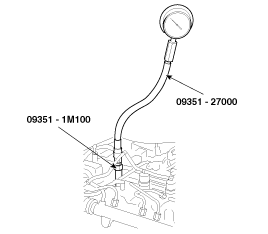Measure the cylinder compression pressure.
Insert the SST (09351-27000, 09351-1M100) into the injector hole.

Cranking the engine, measure the pressure.
Use the fully charged battery for the engine to crank at the speed of 200 rpm or more.
Do the above step (1) ~ (2) again for each cylinder.
This work must be done in as short time as possible.
Compression pressure
Standard pressure :
2157.45 kPa (22 kg/cm², 312.91 psi) / 200 rpm
Minimum pressure :
1863.25 kPa (19 kg/cm², 270.24 psi)
Difference between each cylinder :
294.20 kPa (3.0 kg/cm², 42.67 psi)
If the measured value is below the minimum pressure at one or more cylinders , fill a little engine oil into the injector holes of the cylinders, repeat the step (1) ~ (2) and measure the compression pressure again.
If the re-measured pressure becomes higher, wear or damage of the piston ring or cylinder surface can be the cause.
If the re-measured pressure does not become higher, adherence or poor contact of the valves or inferior gasket can be the cause.
